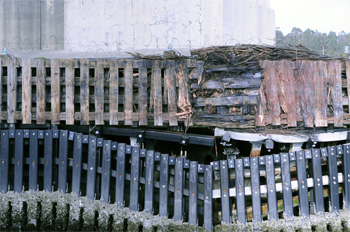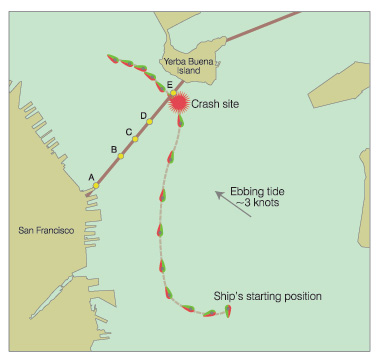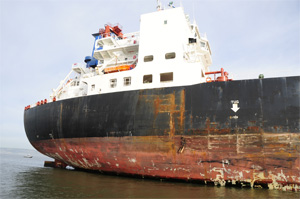A pilot’s last-minute decision to alter course while approaching the San Francisco-Oakland Bay Bridge and the vessel’s master talking on the phone combined to cause an oil tanker to strike the bridge, according to a report released by the National Transportation Safety Board (NTSB).
The 752-foot Overseas Reymar struck the bridge’s tower E on Jan. 7, 2013, damaging the ship and the bridge’s fender system. Damage to the vessel was about $200,000 and repairing the fender system will cost about $1.4 million, according to the NTSB report. There were no injuries and no pollution as a result of the accident, which happened at 1118.
When Overseas Reymar left its anchorage at 1054, visibility was about a half-mile. During transit, both the pilot and the master said visibility decreased to less than a quarter-mile. Just before the accident, visibility was reported to be one ship length.
The pilot told the vessel’s master he would go between towers C and D, which are 1,079 feet apart. However, 80 percent to 90 percent of vessels go between towers D and E, which are 2,210 feet apart.
“I like to make my … routes the same — do the same route over and over again so that if I am in reduced visibility and I’m just relying on the radar, I have the same — I see the same thing over and over again,” the pilot said in the NTSB report.
As the vessel approached the bridge, the pilot noticed that the radar beacon (Racon) between towers C and D, marking the middle of the span, was broken. There was no notice to mariners that this beacon was broken, because state officials did not know about it at the time.
 |
|
Photo courtesy U.S. Coast Guard |
|
The accident demolished part of the fendering system on the bridge’s tower E, resulting in repairs of more than $1 million. |
At 1110 the pilot told Vessel Traffic Service (VTS) San Francisco that he was changing his original course. He would transit not between towers C and D, but between towers D and E. Overseas Reymar was about a mile and a quarter south of the bridge at a heading of 10° and a speed of 10 knots, according to the NTSB report. The ebbing tide was about 3 knots, pushing the vessel northwest.
The pilot ordered a 15° heading and the vessel began a slight turn starboard to line up with the span between towers D and E. At 1111:25 the master got a phone call on the bridge, according to a report by the Board of Pilot Commissioners for the Bays of San Francisco, San Pablo and Suisun. At 1112:45 the master asked the pilot if he wanted to eat lunch at 1130. At 1115 the master took a second phone call on the bridge, hanging up just two seconds before the tanker struck the bridge.
At 1115:15 the pilot ordered port 20° rudder, then hard to port. At 1117 VTS told the pilot the ship was heading directly into the E tower. At 1118 the vessel’s aft starboard side hit the E tower’s fendering.
The broken Racon should not have been a factor in the incident, investigators said. The vessel’s radar showed the locations of the bridge towers, and the ECDIS system could provide navigation information.
“These tools should have been sufficient for an experienced pilot to safely guide the vessel under CD span as he originally intended,” the NTSB report said. “Moreover, VTS data, interviews with VTS personnel and the pilot and crew, and data from the vessel’s voyage data recorder all indicate that by the time the pilot realized the CD span Racon was out of service, it was too late to safely transit through the DE span.”
Several factors contributed to the incident including failure to use effective Bridge Resource Management, lack of or loss of situational awareness, complacency by the pilot and lack of effective communication, the commissioners’ report said.
 |
|
Virginia Howe illustration/Source: NTSB |
|
The track line of Overseas Reymar shows that it strayed too far to starboard before striking the San Francisco-Oakland Bay Bridge’s E tower. Investigators said the accident happened seven minutes after the pilot changed course in poor visibility, aiming at the D-E span instead of C-D. |
The pilot failed to maintain communications and involve all members of the bridge watch. He did not use all navigational tools available to him, the commissioners wrote. Using the 10-centimeter radar, which the pilot said was fuzzy, he did not pick up the return of tower D or the buoys on either side of the tower. He briefly consulted the 3-centimeter radar used by the master, but did not return to it.
The pilot failed to use “parallel indexing” to help him determine what course change should be made to safely transit the span between towers D and E. The pilot “lacked situational awareness by failing to realize the degree of set that the vessel was experiencing toward the bridge in a 3-knot ebb current,” the commissioners report said.
The master failed to use proper Bridge Resource Management by taking the two phone calls just before the incident, so he was unable to help the pilot, according to the NTSB report.
On April 4, 2013, the Board of Pilot Commissioners recommended the suspension or revocation of the pilot’s license. On June 21, the board reached a court settlement with the pilot, according to the court document. His license was suspended for five months, starting July 1, 2013, and he is on probation for two years.
He must do training in Bridge Resource Management, radar techniques and emergency ship-handling. He needs to do 30 observation runs under the San Francisco Bay Bridge.
Overseas Reymar’s owner, New York-based Overseas Shipholding Group, had no comment on the report, said company spokeswoman Helen Harris.

